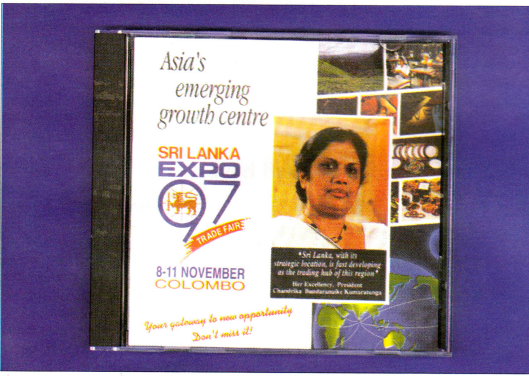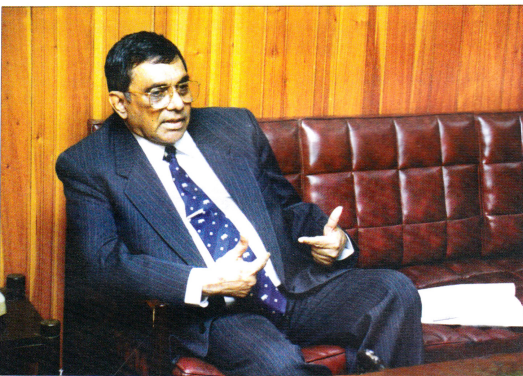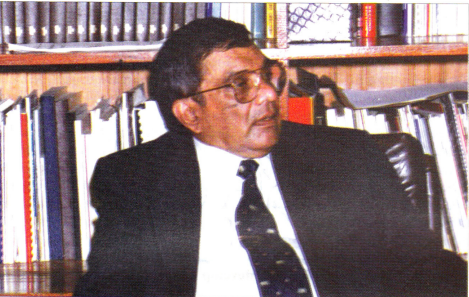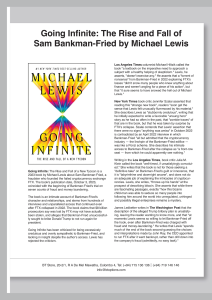EXPO 97 to be held from November 8th to 11th is expected to be one of the biggest displays of Sri Lanka’s capabilities and potential in the export sector. With the new interest in Sri Lanka as an investment center in South Asia, and the growing importance of the South Asian region, EXPO 97, is being planned as one to give the best demonstration of Sri Lanka’s potential for investment, specially in the export sector. It is reported that there is already considerable interest in this event among major business interests both in the East and West. With the inevitable impact that this event will have on trade and commerce in the country, ‘Business Today’ interviewed the Minister of Internal & External Trade, Commerce and Food, Kingsley TWickremaratne, both about EXPO 97 and the general trends of trade The and commerce. Minister was interviewed by Lucien Rajakarunanayake.
EXPO 97 will be a completely different experience from EXPO 94 or any other event that Sri Lanka had to promote the country’s exports and export potential. It will be an event when Sri Lanka will showcase its entire export products. Speaking to ‘Business Today’ on EXPO 97, Kingsley T Wickremeratne said about 360 product items will be showcased, specially at the South Asian Market which would make Sri Lanka a single market place by the Year 2001.
As a result a great deal of interest will be shown by the region itself. It is also different from similar promotional events because it is expected that nearly 50 countries would participate with about 3,000 participants. The minister said the prepublicity for EXPO 97 had been done using the most modern communication methods, to reach a much wider audience than earlier. The pre event promotion had gone Online in the Internet with a special EXPO 97 Website. The registration form itself was on the Website. Registrations are already being paid through the Websites. More than four months before the event, they were already getting registrations daily. Using more use of the electronic media opportunities, a special CD-ROM had been prepared for EXPO 97.
The minister said this promotional innovation included a message from the President, in addition to other relevant information about Sri Lanka, its economy, export potential and other investment attractions. The message from the President had been included because in today’s world, the head of State is the chief executive officer and salesperson for a country.
The involvement of the head of state in promoting exports or trade was now being done even by the United States, where both presidents George Bush and Bill Clinton played active roles in promoting trade, specially with Japan and helping to bring down. trade barriers. Recently, the prime minister of Canada had come with a huge trade delegation to India and bagged US$6 million worth of contracts. We are seeing a new trend in which the head of state of a country becomes its Number One salesperson.
Answering a question as to whether the products Sri Lanka could offer now is what we could develop and expand to meet the demands of the future by the Year 2001, the minister said Sri Lanka had a good range of products and much more potential, which unfortunately were not well known in the country. Sri Lanka was already the major supplier of garments to leading buyers and retail outlets abroad such as Marks & Spencer in the UK, JC Penny of the USA, Eaton in Canada and Grace and Myer in Australia, to name only a few. Sri Lanka was one of the major manufacturers of high quality garments and the product range was wide.
He said Sri Lanka had some of the best products in the world today, in the range that we export. Our jewelry was classed among the best. ‘Right now eight Sri Lankan jewelers are participating in the New York Jewelry exhibition. Earnings from jewelry sales had been increased by about Rs 1.8 billion per year. This is a 30% increase compared to the previous years. Even our exports grew to Rs 201 billion in 1996, which is an increase of 17.5%, from 1995. This year we hope to top Rs 250 billion from exports. Our target is that by the Year 2000 our earnings from ex- ports would overcome our expenditure on imports.”
You said there were a large number of inquiries already about EXPO 97. What are your expectations about participation?
As I mentioned earlier, we have carried out a really high-tech marketing exercise, using both the CD- ROM and also the Internet, among other methods. Conventional promotion has not been ignored. It is the first time that we have used high-tech in such a manner in a marketing exercise for Sri Lanka, to send a message to sophisticated business people the world over. The special CD-ROM has the President’s message, registration procedure, information on tourism, hotels, and tour operators. Also, very important, we have in this CD-ROM the exhibits, the products. The exhibition itself will be online, and people could visit EXPO 97 via Internet, without even coming. They could visit a particular stall, get information about products. So one should not only have to think in terms of those who visit it physically to assess its success, although this number will definitely be very large. It will be declared open by Her Excellency the President on November 17. We have also invited the deputy prime minister of Australia, who has agreed to come with a major delegation. He will declare open the exhibition on the second day. He is also the minister of trade of Australia in addition to being the deputy prime minister. Australia being the second. largest investor in Sri Lanka today, they are looking forward very much to this exhibition.
A lot of interest has been shown in the UK. Our business councils that were established there in London, Leicester, Dorset have visited us and have said they would come, bringing delegations with them to see all the products, skills and potential we will be showcasing. There is considerable interest in Europe too.
That’s quite an optimistic and I think hopeful target to have, but how much of local raw material goes into these products, and are you also thinking of middle and high level technology being developed?
Our approach in the international market is upmarket. We seek niche markets. Sri Lanka can’t produce in volume, but we will go up-market. Take the textile and garment industry. There are pieces we produce at about US$ 550. We will not be competitive enough in the low market where you sell 12 shirts for US$36. Those industries we also support to re-locate themselves in areas such as Vietnam and Bangladesh. We have an advantage in the region itself, more than the others. Some times there are fears that with the proposed SAARC liberalization of trade, Indian textiles will move in, that Indian goods will overtake us. But, in a larger economy a smaller place has a tremendous advantage. What we need of the Indian market or the SAARC market is 0.005 of the market. So it is easy. Also, the advantage we will have is that we will always be seeking to be up-market for the simple reason that our machinery is geared for such markets.
The machinery that we have are mainly from Germany and other technologically advanced countries. In contrast, if you look at India and Pakistan, their machinery is home manufactured. This will give us a great advantage to sell up-market products that come from here, which will have competition in the market. This would be so even in a liberalized market place or in a single market. That is why it is necessary to educate our entrepreneurs to think in terms of upgrading products, produce more for the higher ranges of the market, and demand better prices for quality.
Our traditional export tea, Ceylon Tea, is a good example. It is certainly the best tea in the market. We are now selling Ceylon Tea in its purest form. In the past, I recall that when the President sent me to Russia to expand and secure the market for tea there, they said they got some rubbish in 1992. I explained that no one could give them the best Ceylon tea, except Sri Lanka itself. Not even Liptons. Their tea gardens are not here any more. As a result we were able to get US$2 more for our tea, and today we get fantastic prices for our tea. We have got a good price for rubber too. Even in coconut, we have been able to get a good market for our desiccated coconut. We now get US$1,600 for desiccated coconut, whereas we got only US8800 earlier. We are one of the largest exporters of activated carbon. 60% of the activated carbon that is being used in the coal mines of Australia is now supplied by Sri Lanka. So in those products, the percentage that we get is about 85%, on the value added products too we get about 20%, but in the long run that creates jobs. What we are doing is to have a two-pronged approach. We want to improve our natural and traditional products and also improve and expand the demand for our value-added products. There is much scope for value-added products out of rubber and coconut. Coconut fiber and many other coconut- based products. Also there is graphite. We have the best graphite in the world with 95.5% of carbon. So you can see that we are making every effort to use our own local raw materials for our new industry. This is most important for a developing country that has such a variety of raw materials. We could be having other unknown or untapped resources. The necessary research has to be done for that. But, at the same time, in a competitive market one cannot keep the imported content totally out as well, especially when we look to quality. What we need to do is see how the imported content can enhance our basic product. We must also try to keep abreast in the middle and high tech range of products. What is of even more importance is the development of high-tech skills in our country which could be marketable, opening opportunities for our youth.
Mr Minister, with all this good news, do you not fear the threats and challenges faced by our traditional export products. You expect to develop coconut products as an important value-added industry. But have you no concern about the rate at which the coconut tree is being cut down at present. No doubt. it is mainly done for housing, but what will this mean for the development of coconut-based industries, such as fiber products?
The felling of coconuts for housing or any other purpose has to be stopped, there is no question about that. The Government is taking action about this through the Ministry of Plantation Industry.
This is because coconut is a product, which apart from being an essential aspect of our food, can also make large earnings in foreign exchange. Today, we produce some of the best fiber brushes in the world. There are about 60 companies engaged in this industry. We have been making the Tawashi brushes for Japan, for some time. This had earlier been a cottage industry in Japan. Then, the coconut shell produces activated carbon in a big way, which is in great demand throughout the world. The problem now is one of production. The Ministry of Plantation Industry is looking into this aspect, but the need here too is to educate the people. When I say people, it includes proprietors, managers and labor. We now find it difficult to get coconut pluckers, so we must begin to change the psychology or mind-set of people, in thinking that a particular productive activity is infradig. We can’t continue to call them coconut pluckers. We may have to give them a better name such as coconut harvesting technicians, give them a motor cycle and a uniform, which will give them more respect and pride in their work.
This is a lesson we can learn from the tourism industry. In the past, till the mid-sixties, nobody said his father was a cook, or ‘I am a waiter.’ But today

anyone would say with pride that his or her father is a chef. No youth would be shy to say he or she is a steward or stewardess or waiter or waitress. It is the same job. But they got more money, recognition, they were trained, they obtained a diploma and were given pride in their work. This has to spread to other industries too. Because it is Knowledge Economy that is coming up. Market Economy is making way for Knowledge Economy.
In Knowledge Economy the coconut owner and plucker must sit at the same table and talk issues and problems. Even in offices the workers and employer must as far as possible sit together. It is happening now in countries like Japan where Knowledge Economy is understood, and the adaptation is made. We see it happening in Singapore. They are together. The separation of the worker and manager is becoming a thing of the past and Knowledge Economy is bringing them closer, because everyone is needed. Unlike in the past the worker doesn’t take orders the way it happened. They ask questions, explanations. They need answers. This comes through Knowledge Economy. I must stress, all these years we have been used to getting balance sheets of companies. Even the chairs and tables are given as assets on the balance sheet. But the human resources, the labor, is not mentioned as an asset in a balance sheet. In Knowledge Economy, labor or human resources would be the number one asset on a balance sheet.
It is an interesting thought, and a good phrase that you mentioned, Knowledge Economy. But if I might digress from matters of commerce and trade, and move into a somewhat controversial area, do you think our educational system is structured to produce this Knowledge Economy or knowledge based economy which you mention?
Our educational system is being re-structured to meet this need. But that will certainly take some time. However, the more urgent need is entrepreneurship in a big way. Ja- pan, had its own educational system, but have mastered entrepreneurship. English is a vital factor. In Japan, top businessmen, chairmen of corporations, presidents, managing directors, finish their work and go for English classes in the night. They call it the business language. The Germans do the same. Here too our children are doing the same. They need it. They realize its importance. They know that without English, very often they are shut out of employment. But the problem here is somewhat different. Even those who know some English are scared to speak it. They feel that if they make a mistake they will be laughed at. Their accent will be laughed at. But when the Japanese say ‘No can do’at world conference &, we don’t laugh. When the Germans say ‘unpossible’ we don’t laugh. They still transact their business. It is time we realized that English is but more than a language, a means of communication. If the Japanese could speak his Japanese English, the German could speak German English, the West Indies speak what may be called broken English, the Sri Lankans should be able to speak Sri Lankan English for the purposes of business.
In Knowledge Economy the English expression itself is changing. People are learning a new English of short sentences and phrases. The fax machine has changed things. In certain institutions they are teaching this shorter, more focused English that is required for business. It is called the fax language. One does not have to go into great length to send a message that is easily understood. The fax language is one of short sentences, one-word messages. If I give you an example I’m arriving. 7.30pm. Today. Colombo Airport.’ Earlier this message would have been much longer. But one has to calculate in terms of returns now. This language is cheaper to transmit. In a way this kind of language was used by Ernest Hemingway, when he reported the war. It was an accepted style. The staccato sentence. So we have to think of new ways to introduce Knowledge Economy to our own entrepreneurs. They must measure the knowledge of English of a job applicant with a different yardstick. Will this person be able to communicate business matters in English, after some training. Not whether the person is excellent at lengthy prose, which is hardly required for most business transactions.
To get back to EXPO 97, while this interest in the exhibition among the foreign business community you are targeting exists, has there been any indication that they have concerns about the security situation prevailing in the country?
We have had no such indications so far. In Australia there were no such concerns. We have not been told of such concerns in the UK or other countries from where there will be delegations. There are many leading companies from foreign countries operating in Sri Lanka already. Some are in fact networking with Sri Lanka. They know the actual situation. They feel that the war is waning off and it is safer here. As businessmen, they would like to take that additional risk, if there is any and come, because if they come at this time they can get tremendous advantages. They could get land for their enterprises at much cheaper rates, as well as other facilities at more economical rates. Whereas, if they wait till tomorrow the cost of these facilities might go up, and they may even have to be in a queue. So, the alert business is aware that when it goes into a country it must be there first, to take best advantage of the concessions and incentives offered.
Most of these people are today looking at Sri Lanka as a base for investment, while buying goods from here. How they could come into joint ventures here, specially on how to use Sri Lanka as a platform to move into and penetrate the future SAARC market, as a gateway to the South Asian market of 1.2 billion people, of which 400 million people have the buying power equal to the European Union. This 400 million is an unsaturated marketplace. I say so because still there is room for a TV set in the bedroom, room for a telephone in the bathroom. There is plenty of room for a car in a garage. This middle class is a rich middle class, especially when you realize that 280 million people in India are richer than those in many other countries. It is a truly massive marketplace.
You said earlier that there would be no serious threats to our exports from the kind of development that is taking place. But there have been reports in the Press and other complaints especially with regard to consumer items, agricultural produce and things like that. What are the plans and strategies of your ministry and the government to offset these dangers?
In business, especially trade, there are always dangers. We have to accept the fact that in the past markets moved very slowly. We got a market, we enjoyed that market for a couple of years. Some enjoy the market for a generation, some for ten to fifteen years. But markets are changing very fast now. We are trying to get our people ready for change. They have to adapt to quick changes. As I said earlier, there is no danger to business as such. But certain businesses that are not competitive in the marketplace will die off. Business that is competitive enough and survive will prosper. So it does not mean the same business will be there tomorrow. Some other business will come in. This is what is taking place all over just now, because by the Year 2000 the word protection will be out of the dictionary of commerce. The name of the game would be competition and three basic elements would be speed of delivery, quality and presentation. So we are educating our small and medium scale industries, and big industries as well, to take advantage of the new trends and adapt to them.
There is today the World Trade Organization, at rule-based organization. We, the Department of Commerce and all those associated, are always in touch with the changes that are taking place in the world, whether it involves NAFTA or the European Union, or an Indian Ocean Rim country, and we bring this information to our people, our entrepreneurs, our exporters. For example, there is Euro-packaging. Now it is important that we are there first with Eurb-packaging, and we are taking steps to do that.

But the problem is that some people are not ready to accept change. Their minds are like concrete. This is our problem. They want to do business the way their fathers did business. Just look at the indicators of the past 20 or 30 years. The companies that have done well are mostly those that are listed in the Stock Exchange. There are about 30,000 companies registered under my ministry which are still proprietorships, partnerships and in the family. Only about 240 companies are listed on the Stock Exchange. Now these other companies should go out and marshal social capital. They complain that interest is high. But the best method, as seen in many countries is to obtain social capital through the stock market. This is capital that is interest free. You use it for development. But, another important aspect is that you get new people coming on to your board. They bring in new blood, new thinking, different experience and expertise which can all help. But if you keep the business in the family that type of business might find it difficult to survive in the coming Knowledge Economy.
In addition to being the Minister of Commerce and Trade, you are also the Minister of Food. Often we get to know of situations like the recent development over chillie production. You mentioned that a certain number of industrialists are slow to learn, but in what we have been taught to be as an agricultural economy, and with certain traditional patterns of agriculture, how does one tackle the problems of shortages and excess production that are happening which cause major problems to the cultivator?
Where I am concerned I look after the consumer and at the same time protect the farmer. This ministry for trade since its inception has always been criticized, and has been at the receiving end of much ill- informed abuse. When the prices go up the consumer shouts, when the prices go down the farmers protest. So you have to create a balance. What happened in the past was that the middleman was always dominating. Take the case of chillies. Chillies were sold at Rs.140 a kilo for 17 years. If the farmer had got that price he would be having the cellphone and the double-cab. He is still poor. He never got the proper price when chillies were Rs.140 because at that time there were only three people who were allowed to import chillies. There was a shortage because we need 15,000 MT of chillies per year. There is a major shortfall in the production. So if we don’t meet the market demand, our chillies would have been about Rs 200-250 a kilo. So, even the previous government imported chillies, but they gave the licence only to three people. They fixed the price at Rs 140 Everybody sold at that price. But when we came to power we allowed chillie imports under Open General License. About 300 people imported chillies and there was competition in the marketplace and the price came down. It came to about Rs 75 to Rs 80. The advantage went to the consumer. For the first time after 17 years the consumer was able to get chilies at Rs 70 a kilo. But the middleman still continued to buy from the farmer at Rs 45, which was what they paid even earlier and sold at the new price.
The situation has changed today. Earlier, all the chillies produced in growing areas such as Anuradhapura were brought to Colombo by middlemen and sold at higher price. Now the farmer is selling it at the farm itself. Those who go to Anuradhapura, Dambulla and other chillie growing areas will see little huts where the farmer is selling his own produce. Now the farmer has entered the market directly. For the first time they are getting Rs 65 to 70 per kilo. We had a market distortion, when politicians started shouting and carrying out propaganda about the price of chillies. It was not the farmer who carried on the propaganda. It is the middleman.
Take the potato cultivation up-country. The farmer is only a worker. He works on land owned by others. Twenty to thirty acre plots owned by government officials, police officers, CWE regional managers, and such people. The farmer is a daily paid man. When they hold a poster to demonstrate against me, he is paid Rs 200 per day. The poster is printed in Colombo. This is done by the middleman, who has so far been surviving on political patronage, whichever the government that came in. So this is what one has to break through. To a great extent you will be happy that we have broken through. The price of chillies is coming down. Potatoes are Rs 35 when it was Rs 90 earlier. The consumer gets it at a lower price, so inflation has and can be reduced or curtailed. The basic problem now is the productivity of the farmer. The farmer still looks at the price per kilo, rather than looking at the yield per acre. The productivity here is far below that of even other countries in the region such as India and Bangladesh. If we double the yield per acre our prices will come down in the market, and the farmer will have more to sell. The consumer will benefit by the better price and the farmer will benefit from the larger volume.
Your story about chillies was quite interesting, but I think if the prices come down as you expect, the medical profession will get alarmed, about an increase in cirrhosis of the liver, just like from alcohol. However, you used the word consumer, and you said the consumer benefits. But at the same time there are impressions that the consumer is ultimately caught between government on the one hand and trade on the other, whether it is the producer, importer, middleman or whoever it is. How does the Ministry of Commerce, and you as the minister in charge, hope to strengthen the consumer movement.
I have been trying for the past two and a half years to create a good consumer movement. I have tried to help set up consumer associations. The problem is that our consumer takes everything for granted. We have explained the need for consumer activity to the Housewives Association, various interested NGOs. We are trying to educate the people on the need for a strong consumer lobby and movement. It is the consumer who has to play a major role. In a market economy it is the consumer who has to protest. One can’t have controls. They are a thing of the past. If I had controls now, we would be running back to the seventies. One thing I am
happy as the minister of food is that from the time we came in there have been no shortages, no queues. When last year due to the drought there was a 600,000 ton shortage of rice in the country there were no controls. The market had plenty of rice from Pakistan. Bangladesh, Vietnam. There was no shortage and the prices were fair. In this exercise the consumer himself or herself must organize, and we have been trying to move them into this, but they don’t respond. For example, when I bring the prices down and the middleman protests with posters and various other means, our consumer is in sympathy with that middleman and not with us.
Isn’t it possible for the party or parties in power to develop a very strong consumer movement in our country?
We have tried it, two years ago. I have all the associations. I got the NGOs and we had a massive meeting, and membership right round. I asked them why they were not protesting. I said that even if the CWE sells goods at a high price, to make their protest felt. Take a poster and picket there. This is happens what abroad against multinationals that offend the consumer. We gave all the facilities and encouragement, but we don’t want to show our hand behind it, that we are doing it. It is the consumer who must do it. But, the consumer takes it for granted and is inactive. It is high time they woke up. If you can get this message across a journalist, I would be grateful.
I am a consumer who would protest any day. Apart from that, we understand the importance of protest and that it is one of the key areas where civil society has to intervene. But civil society in Sri Lanka somehow seems to be lacking in such intervention. Mr Minister, as the Minister of Commerce in this country, with the level of business development that is taking place, how do you place Sri Lanka today as a commercial center. I am not merely talking of an export center, but as a commercial center, in the true sense of it.
What Hong Kong has been to China, Sri Lanka would be that Hong Kong in the Indian sub-continent by the Year 2001. Also, a small country like Sri Lanka will be the gateway to South Asia and

we will be working by the Year 2001 in alliance with Singapore. Right now we are making the necessary arrangements through our ministry. Because, in our development plan for the port, by the year 2003 our port will be the second largest port in the world.
You mean the Port of Colombo?
Yes. Colombo. Right now 75% of trans-shipment in the region is back in Colombo. Singapore is the largest port. Recently we met with Singaporeans and had discussions. We will not compete with each other, we will complement each other. We will work as an alliance, so that we will be the gateway to Asia itself. Singapore has also understood this and is working towards this. Even in tourism we will carry out marketing together. They will package Sri Lanka with Singapore. Relax in Sri Lanka and shop in Singapore.
SAARC will be a massive market and we will be the gateway to that market. And, I will repeat, what Hong Kong has been to China we will be to the In dian sub-continent.
What you say is interesting, but your statement about the harbor causes some concern. I have been reading some material which says that Hambantota offers a very good prospect for a deep water harbor in Sri Lanka. What about that as- peet of development.
What I meant was the second largest harbor in container handling. Colombo will be a container port. So we could handle any ship in the world. By the Year 2003 or 2005 Singapore would still be the largest container handling harbor in the world, and we would be the second. We are preparing ourselves to be ready to face the realities of the emerging global market, and not the group or sector markets of today. We have to join hands with those who can work with us in products and services, without competing with each other. We must enlarge our supply base. It is happening already.
You recently held a two-day seminar for government MPs on the devolution proposals. What effeets do you say there will be on commerce and trade in the country due to wider devolution?
In commerce and trade there is no race, colour or creed. You can see this in SAARC. It was not SAARC that moved but SAPTA that moved. Business is the main facilitator in bringing nations and peoples together. I would say we had a very successful seminar. Devolution can only lead to an improvement in commerce and trade. There will be new regional markets developed, new resources tapped. It can only help commerce and trade, and thereby help in the better bonding of our people. I am happy about our president and what she has done. After all, the SLFP had been a Sinhala Buddhist party for more than 25 years. But with her entry she has been able to transform over 2 million members of this party, not to think in terms of race or creed, but to think as Sri Lankans who belong to one nation. So within a single nation, regional trade can only prosper. The re-programing of our own party is the greatest good she has done to this country.
Devolution will strengthen democracy, and in the frame of democracy free markets will emerge.
My final question. How would you state the future of Sri Lanka in five years time, if you use the kind of phraseology that you liked of Ernest Hemingway?
Our GNP doubled to 25 billion US dollars. Per Capita income will rise to 1,300. We will be the up- market place. Sri Lanka will be entering a phase of the developed world. I look for that day. I am sure that could be done by the Year 2003. And I am optimistic.
Lucien Rajakarunanayake is a leading journalist and political commentator. He contributes both to the Sri Lankan and Foreign Press, and writes two popular weekly columns in English and Sinhala






